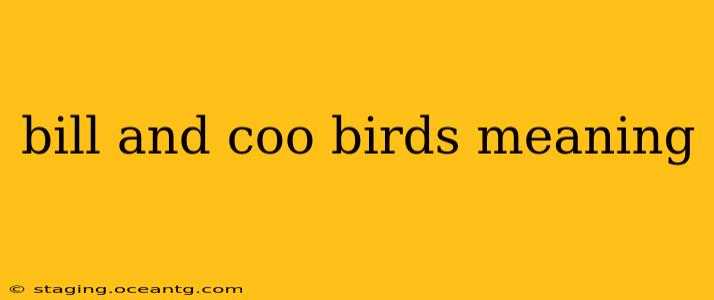The phrase "bill and coo" evokes images of gentle affection and tender intimacy, often associated with lovebirds. But what exactly does it mean, and where did this charming expression originate? This post delves into the meaning of "bill and coo," exploring its origins, usage, and the symbolism it carries.
What Does "Bill and Coo" Mean?
"Bill and coo" describes the gentle sounds and affectionate behavior of birds, particularly doves and pigeons. The "bill" refers to the bird's beak, used in gentle nudging and feeding behaviors, while the "coo" represents the soft, murmuring sounds they make to each other. Therefore, "bill and coo" figuratively describes affectionate displays between people, characterized by gentle caresses, soft whispers, and tender displays of love.
Where Did the Phrase "Bill and Coo" Originate?
The exact origin of the phrase is difficult to pinpoint, but its use dates back to the 16th century. Early iterations appeared in literature as a way to describe the affectionate sounds of doves, highlighting their perceived gentleness and intimacy. Over time, the phrase transitioned into a metaphorical description of human affection, emphasizing the tender and loving nature of a relationship.
What Kind of Birds Bill and Coo?
While the phrase is often associated with all lovebirds, it's most accurately associated with doves and pigeons. These birds are known for their soft, cooing sounds and the gentle manner in which they interact with their mates, making them the perfect inspiration for the idiom. Other birds might exhibit similar behaviors, but doves and pigeons remain the quintessential "bill and coo" birds.
Is "Bill and Coo" Always Romantic?
While "bill and cooing" primarily conveys romantic affection, it can sometimes describe other forms of close intimacy. For example, a parent might "bill and coo" with a child, expressing tender affection and care. However, the primary and most common usage remains within the context of romantic relationships.
What's Another Way to Say "Bill and Coo"?
There are many ways to express the sentiment of "bill and cooing," depending on the desired level of formality and the specific context. Some alternatives include:
- Canoodling: This implies more physical affection.
- Cuddling: Focuses on the physical closeness and comfort.
- Being lovey-dovey: A more informal and playful way to describe affection.
- Showing affection: A more general term encompassing various displays of love.
- Engaging in tender moments: A more formal and descriptive alternative.
The Symbolism of Bill and Cooing
Beyond its literal meaning, "bill and cooing" holds symbolic weight. It represents:
- Gentle affection: The softness of the sounds and movements associated with the phrase emphasize a tender and delicate form of love.
- Intimacy: The close physical and emotional proximity suggested by the phrase highlights the deep connection between individuals.
- Tranquility: The peaceful nature of doves and pigeons further contributes to the sense of calm and serenity associated with the expression.
- Commitment: The lifelong pair bonding often observed in these birds strengthens the association of "bill and cooing" with lasting relationships.
In conclusion, "bill and coo" is more than just a quaint expression; it's a rich and evocative phrase that encapsulates the essence of gentle affection and tender intimacy. Its enduring use speaks to its ability to capture a feeling that transcends time and cultural differences, reminding us of the beauty and simplicity of loving connections.
